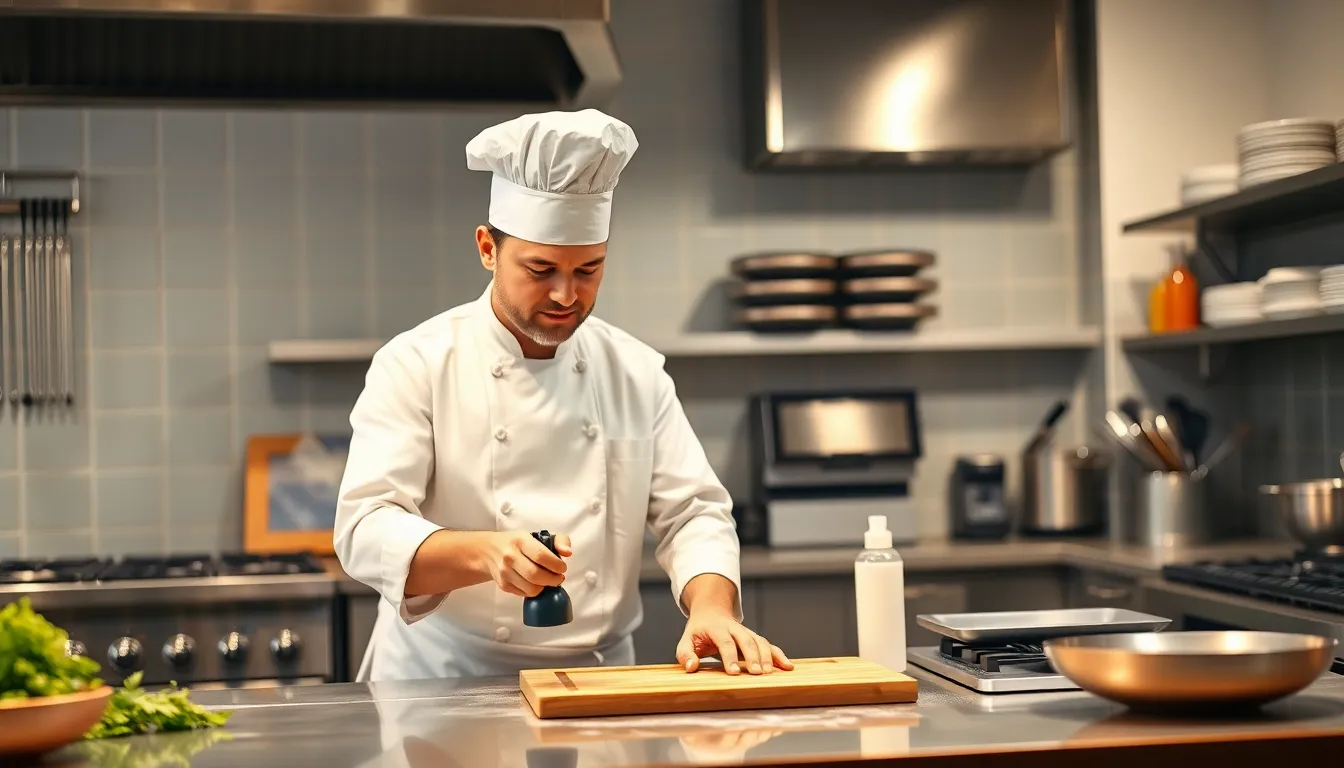Table of Contents
ToggleIn the culinary world, the last thing anyone wants is a surprise guest—especially when that guest is an allergen. Cross-contact can turn a delightful meal into a culinary catastrophe, leaving diners feeling more than just a little uneasy. But fear not! There’s a simple step that can help keep those pesky allergens at bay and ensure everyone enjoys their meal without a hitch.
Understanding Cross Contact
Cross contact occurs when allergens inadvertently mix with safe foods, posing significant risks for individuals with food allergies. Recognizing this critical issue ensures safer dining experiences. Common sources of cross contact include shared utensils, cutting boards, and preparation surfaces.
In busy kitchens, both proactive and reactive steps help mitigate risks. Staff members must always designate separate equipment for allergen-free food. Cleaning surfaces thoroughly between uses also plays a vital role in preventing unwanted allergen transfer.
Awareness of food preparation and service processes greatly reduces cross contact occurrences. Training employees on proper food handling techniques is essential. Utilizing labeled containers for allergenic ingredients informs staff and minimizes mistakes.
Implementing standard operating procedures further enhances safety. Restaurants often benefit from developing allergen-safe zones. Installing dedicated cooking equipment for specific allergens limits exposure to cross-contact risks.
Regular audits and inspections ensure adherence to safety protocols, reducing the chances of allergic reactions among diners. Constantly reviewing and updating allergen management practices aligns with the commitment to customer safety.
Creating a culture of allergen awareness fosters responsibility among kitchen teams. Encouraging open communication regarding dietary needs enhances guest confidence in the establishment’s allergen management. Observing these steps provides a comprehensive approach to preventing cross contact and ensuring safe dining experiences for all guests.
Importance of Preventing Cross Contact

Preventing cross contact is essential for maintaining health and ensuring food safety in culinary environments. Both aspects heavily impact diners who have food allergies.
Impacts on Health
Cross contact poses serious health risks for individuals with food allergies. Exposure to even trace amounts of allergens can lead to severe allergic reactions. Symptoms may include hives, swelling, and in extreme cases, anaphylaxis. Vulnerable populations, such as children, benefit greatly from stringent measures aimed at minimizing exposure. The health implications underscore the necessity of thorough training for kitchen staff in allergen management practices. Moreover, the implementation of clearly identified allergen-free zones can significantly reduce incidents, allowing everyone to enjoy their meals without worry.
Impacts on Food Safety
Food safety relies heavily on preventing cross contact within kitchens. Shared utensils and preparation surfaces can inadvertently transfer allergens to safe foods, contaminating dishes. This contamination not only jeopardizes the health of allergic individuals but also compromises the restaurant’s reputation. Establishing clear protocols for the use of designated equipment is vital for maintaining safe food handling practices. Furthermore, regular cleaning between food preparations helps ensure adherence to safety standards. Ultimately, a proactive approach to food safety fosters trust among customers, reinforcing the establishment’s commitment to providing safe dining experiences.
Key Steps to Prevent Cross Contact
Preventing cross-contact requires careful attention to detail in food preparation environments. Implementing specific practices safeguards individuals with food allergies.
Step 1: Proper Food Storage
Store allergenic ingredients separately from non-allergenic ones. Utilizing clearly labeled containers eliminates confusion. Cold storage areas, like refrigerators or freezers, should have designated shelves for allergenic products. Separate storage prevents unintentional mixing during inventory checks. Keeping a well-organized pantry reduces the chance of cross-contact. Regularly check expiry dates on all items to ensure freshness and safety.
Step 2: Separate Preparation Areas
Assign distinct areas for preparing allergenic and non-allergenic foods. Utilizing separate countertops ensures that surfaces do not inadvertently transfer allergens. When creating a designated space, it’s crucial to minimize traffic between areas. Clearly marking preparation zones helps staff understand their responsibilities. Regular cleaning of each zone further reduces contamination risks. Using color-coded mats can reinforce visual separation and enhance allergen management.
Step 3: Using Designated Equipment
Utilize separate utensils for allergenic ingredients to drastically reduce cross-contact risks. Specific cutting boards, pans, and knives should remain exclusive to allergenic foods. Clearly label equipment to avoid mix-ups during busy service times. Staff training ensures everyone understands the importance of dedicated tools. Regular audits of equipment also confirm that allergen-free practices remain intact. A consistent approach to using designated equipment fosters a safe culinary environment.
Best Practices in Food Handling
Proper food storage plays a foundational role in preventing cross-contact. Allergenic ingredients must remain in clearly labeled containers and placed on separate shelves. This intentional separation avoids any chance of mixing during storage.
Creating distinct preparation areas is vital. Designate specific zones for allergenic and non-allergenic foods, which minimizes overlap. Using color-coded mats can enhance visual separation, further protecting against cross-contact.
Utilizing dedicated equipment contributes significantly to allergen safety. Exclusive utensils and cutting boards should become standard for handling allergenic ingredients. This practice reduces the risk of transferring allergens to safe foods.
Training staff on proper food handling techniques strengthens overall allergen management. Regular training sessions ensure employees understand methods to prevent cross-contact effectively. Audits and inspections of food handling practices maintain high standards and accountability.
Implementing standard operating procedures gives structure to allergen management. These protocols define clear actions to be taken when handling allergenic ingredients. Establishing allergen-safe zones reinforces the importance of these measures.
Regular audits serve to evaluate compliance with safety protocols. These assessments help identify areas for improvement and hold staff accountable. Fostering a culture of allergen awareness across kitchen teams builds confidence among customers regarding the establishment’s commitment to safety.
Preventing cross-contact is vital for ensuring the safety of diners with food allergies. By implementing clear protocols and dedicated practices, establishments can significantly reduce the risk of allergen exposure. Proper food storage and designated preparation areas play a crucial role in this effort.
Training staff on these measures fosters a culture of awareness that benefits both employees and patrons. Regular audits and inspections further reinforce commitment to food safety. Ultimately, taking these steps not only protects vulnerable individuals but also enhances the overall dining experience, building trust and confidence in the culinary environment.




